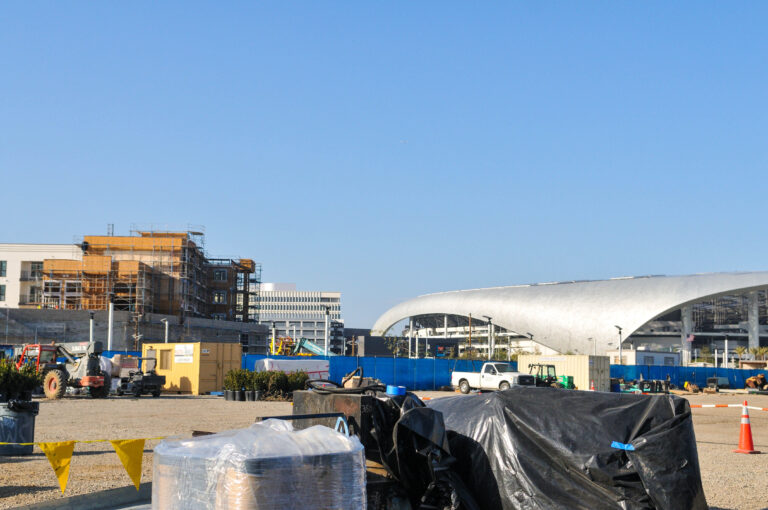
For most cities, working on the redevelopment of a nearly 300-acre site that is one of the largest urban mixed-use planned developments in the Western United States might have been enough to fully consume their planning and economic development departments for years.
Add to the mix the fact that in 2014, Stan Kroenke, owner of the-then St. Louis Rams, was making regular headlines as to whether “will he or won’t he” invest hundreds of millions of dollars to build the new SoFi Stadium and transfer the Rams back to Los Angeles as part of this massive development. For just about any city, this would have been an all-consuming project.
Any city, that is, except Inglewood. Around the same time, as the entire state watched with anticipation whether the former world-famous racetrack known as Hollywood Park would be home to one or even two National Football League teams, Inglewood had its sights set on redeveloping multiple areas of the city.
On Nov. 1, 2016, the city adopted its Downtown and Fairview Transit Oriented Development Plan and Design Guidelines. Among the many lofty visions touted in the 2016 plan for the historic downtown area were the following: “Downtown is a place to live, work, shop and be entertained; downtown is a revitalized, yet forward-looking gathering place for the community; downtown is a major economic engine providing jobs, sales tax and other revenue; downtown expresses the unique culture of Inglewood.”
What makes these statements unique is the context. Market Street – “Downtown Inglewood” – is located roughly 1 mile away from SoFi Stadium and the Hollywood Park development. While the Hollywood Park site was the target of significant new capital, Market Street sat idle for decades, quietly gathering dust like an unused Hollywood movie set. What was once a bustling commercial core of jazz clubs, art galleries, coffee shops, and restaurants situated along a maintained boulevard with wide sidewalks and manicured medians, Market Street had become littered with abandoned buildings, empty storefronts, struggling businesses and little pedestrian activity.
Revitalization course
City leaders, along with a few daring entrepreneurs and developers, decided it was time to bring back this once-vibrant area and set the course for revitalization with the 2016 plan. The plan’s urban design concept envisioned distinct areas along Market Street and the development of a new Techtown Campus on city-owned property designed to entice new, innovative companies to relocate to Inglewood. There is also an area of town designated as the Downtown/Techtown Arts District, which expects to build on the existing strong arts community of Inglewood and the anticipated new science and technology industries that will take root.
A critical focus of the plan is understanding how to bring together people, cars and commercial activity while managing traffic, parking and pedestrian flow. Thankfully, forward-thinking cities in Southern California are not just incorporating public transit in the mix; they are (finally) making public transit stations the cornerstone of new development areas. In Inglewood, the Downtown Inglewood Metro Station is the linchpin. This station is on the Crenshaw/LAX line, connecting Inglewood to downtown Los Angeles to the northeast and to Los Angeles International airport to the west. Once the station was designed, funded and construction began, the city turned its attention to redevelopment of Market Street and downtown Inglewood.
The city of Inglewood realized that in order to create these new areas they needed to change planning and zoning laws to allow for greater density, taller buildings and a more expansive mix of commercial retail, hospitality and residential uses. And this needed to be done along an existing street with many historic buildings, including the shuttered Fox Theater. According to the city’s 2016 plan, “quality building shopfronts should be preserved, enhanced, and restored as necessary, while more plain building façades may be enhanced or replaced with new retail buildings. The plan also encourages residential construction behind and on top of ground floor retail to help animate retail activity.”
The approach is seeing success. At a recent event hosted by the Urban Land Institute, the excitement was palpable. More than 100 developers, architects, consultants, investors and residents gathered to listen to Inglewood Mayor James Butts, Councilmember Eloy Morales, Economic and Community Development Director Chris Jackson, as well as current developers along Market Street, discuss these changes and the city’s vision for its downtown arts and technology districts.
One of the success stories discussed, and later toured that evening, is the Miracle Theater. Built in 1937, the Miracle Theater has had numerous lives and uses before its current owners remodeled the entire building in 2017 and created a prominent, live music/arts venue with a full bar and certain specialty food items.
Inglewood’s dual transformation – at Hollywood Park and in the historic downtown along Market Street – demonstrates the value created when opportunity meets good planning. As Mayor Butts is fond of saying, “The only thing that has changed in Inglewood, is everything.”
Ellia Thompson is a land use attorney with Venable LLP. Christopher E. Jackson is Inglewood’s economic and community development director.
